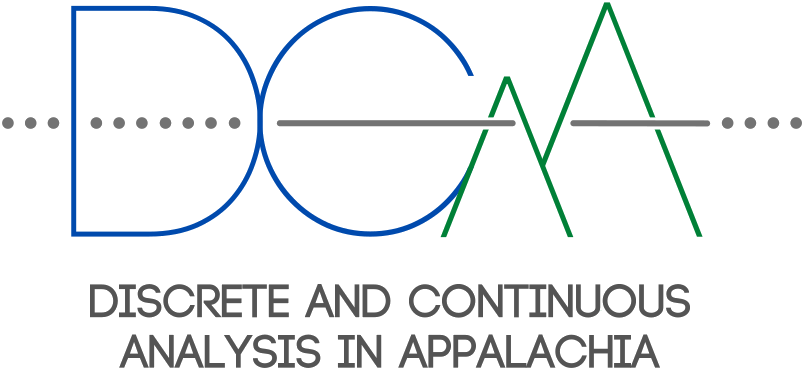Discrete and Continuous Analysis in Appalachia

About the REU site
Discrete Continuous and Analysis in Appalachia (DCAA) is an REU focused on introducing students to different aspects of mathematical analysis through differential equations, difference equations, and the general theory of time scales calculus and their various applications. Participants will receive a $4,800 stipend and paid housing for 8 weeks during Summer 2023.
Dates and deadlines
Dates of REU: 5 June 2023-28 July 2023
Location
Participants will be housed in a dormitory at Fairmont State University. Housing is 100% paid for by the grant (i.e. it does not come out of the stipend!).
Fairmont sits at the epicenter of West Virginia's "High Tech Corridor" and Fairmont itself is home to the I-79 Technology park, which houses NASA's Independent Verification and Validation facility, a NOAA supercomputer lab, and numerous other high-tech government contractors and businesses. West Virginia University, an R1 research institution, is 25 minutes to the north in Morgantown, which is also home to a number of high-tech businesses. The FBI's Criminal Justice Information Systems building is 20 minutes to the south in Clarksburg.
Local infrastructure exists to facilitate travel for participants without cars. There is a bus service in Fairmont that runs six days a week; rates for this service are affordable and includes routes to local recreation, shopping, and dining locations in Fairmont as well as the nearby cities of Clarksburg, Bridgeport, and Morgantown. Those respective cities also have their own transit authorities with comparable services. Fairmont also hosts a Greyhound bus station for travel to more distant locations.
How to apply
As per NSF rules, participants funded by DCAA must be US Citizens or Permanent Residents of the United States and have not yet received their bachelors degree during the program (if you graduate in Spring 2023, then you are unfortunately not eligible to participate). Students who are women, underrepresented minorities, first-generation college students, and those whose home institution have limited research opportunities in mathematics are encouraged to apply. Participants are expected to work on research and related activities full time (40 hours a week)! The ideal applicant will have met the suggested project prerequisites listed below, but we will entertain applicants with any typical "sophomore-level or higher" mathematical background.
If you are accepted into the program, then we will have to verify your citizenship status in order for you to receive funding. Expect to provide a copy of a birth certificate or passport (or other document verifying citizenship) for verification!
Please fill out our application form here
Projects
There are four mentors who will supervise projects as described below:
Dr. Tom Cuchta (special functions)
- discrete hypergeometric series
- matrix hypergeometric functions
- generalizations of hypergeometric series (e.g. to time scales)
- Recommended prerequisites: differential equations OR real or compelex analysis OR linear algebra
Dr. Sabrina Streipert (biological mathematics)
- mathematical modeling in biology
- global dynamics of discrete planar maps
- analysis of mathematical models in time scales calculus
- Recommended prerequisites: linear algebra AND at least one of modeling OR differential equations OR discrete mathematics OR programming in Python, R, or Matlab
Dr. Nick Wintz (control theory)
- using and creating various models via the Kalman filter
- control theory with conformable derivatives
- non-cooperative game theory
- Recommended prerequisites: linear algebra OR differential equations
Dr. Robert Niichel (probability and statistics)
- Lewis Carroll's triangle problem
- maximum likelihood estimators on time scales
- statistics project
- Recommended prerequisites: probability course OR basic statistics course OR linear algebra

The opinions, findings, and conclusions or recommendations expressed are those of the involved faculty and do not necessarily reflect the views of the National Science Foundation.





